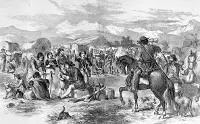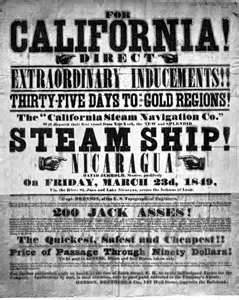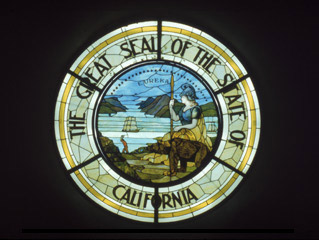The Making of the 50 States: California
Part 2: The Rest of the Story 
The Corps of Discovery led by Meriwether Lewis and William Clark had reached the Pacific Ocean in the early 19th Century. Their reports of the lands they visited spurred interest in new settlements westward toward the Pacific, and it wasn't long until settlers began to arrive in California. Kit Carson helped blaze the Santa Fe Trail to Los Angeles in 1832. The Oregon Trail and the California Trail were also avenues of travel for many making their way to the West. Some of the first known Americans to arrive were trappers, in particular Jedidiah Smith, who came to the area in 1826. A larger party of settlers led by John Bartleson and John Bidwell arrived in 1841. Bidwell went to work for Johann August Sutter, a German-born Swiss businessman who had arrived in San Francisco in 1839 and ended up with a very large amount of land that he called New Helvetia. The settlement, at the junction of the American River and the Sacramento River, had wheat fields, orchards, and vineyards. It also had a fort, which became a destination for settlers who followed in Bidwell's footsteps. When the United States annexed Texas in 1845, the Mexican government refused to have any more to do with the U.S. diplomatically. Mexican authorities in California ordered all undocumented settlers to leave under penalty of punishment. The Mexican government had long been unstable, with dozens of changes in leaders in the short time since its independence. 
The California Republic was established in June 1846. This was the Bear Flag Revolt, which began with a party of settlers occupying Sonoma Plaza and flying the Bear Flag in defiance of Mexican rule. One of the leaders of this independence movement was John C. Frémont; Carson also ended up in the struggle. The California Republic, also known as the Bear Flag Republic, lasted one month, but soon after Mexico and the U.S. were at war. A strong U.S. naval presence seized all of the California ports, but that was the extent of the fighting in California. Mexico surrendered California to the U.S. in 1847, and California had its independence. The Treaty of Guadalupe Hidalgo, ending the war, was signed on Feb. 2, 1848. Just a few days before, gold had been discovered in northern California.
James Marshall was the first to discover gold in California, on Jan. 24, 1848, on the South Fork of the American River, right next to the sawmill of John Sutter (the same Johannes Sutter who had set up Sutter's Fort and New Helvetia). In just four years, the population of California skyrocketed from 14,000 to 250,000, reaching 90,000 in the first year alone. The California Gold Rush was on. The surge in population and interest in California transformed the territory. Gold mining fever drove many elements of industry and enticed many people to follow dreams of easy money. Most of those people found nothing of the sort. The free-wheeling atmosphere led to disputes over the value of currency and even questions of who was in charge in terms of lawmaking and law enforcement.
The nominal head of California was a military governor. Then-President James K. Polk implored Congress to pass legislation making California a territory, putting it on the fast track to statehood; Congress, consumed with a balance between "free states" and "slave states," refused. Without territorial status, Californians gathered for a constitutional convention, which produced a constitution (in 1849), which was then approved by a majority of California voters. The first capital was San Jose. A provisional government followed and governed for most of a year before Congress approved California's appeal for statehood. California became a state on Sept. 9, 1850, as part of the Compromise of 1850. First page > In the Beginning > Page 1, 2 |
|
Social Studies for Kids
copyright 2002–2024
David White






